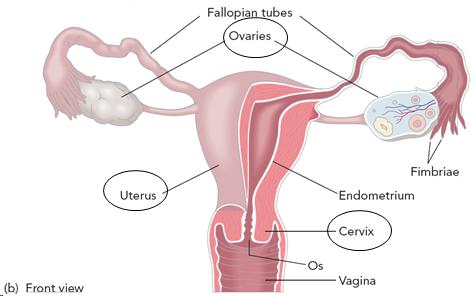
Female Sex Organs: Internal Structures
12

The uterus, or womb, is a hollowed thick wall muscular organ. The tapered end of this pear-shaped organ is known as the cervix. The cervix extends downward and opens into the vagina. If a woman has not given birth, the uterus is about three inches long and three inches wide at the top. For women who have given birth, the uterus is somewhat larger. During pregnancy the uterus expands to the size of a volleyball or larger to accommodate the developing fetus. The inner lining of the uterine wall is known as the endometrium. It is filled with tiny blood vessels. This tissue is built up due to hormonal changes throughout a woman's monthly menstrual cycle in preparation for a fertilized egg. If fertilization has not occurred, the endometrium is shed and expelled through the cervical opening. If fertilization has occurred, the pre-embryo is embedded in the nourishing endometrium. On each side of the uterus is a pair of ovaries. The ovary is a gonad, which is an organ that produces gametes. Female gametes are oocytes. The ovaries are the size and shape of large almonds. In addition to producing oocytes, they serve the important function of producing hormones such as estrogen, progesterone, and testosterone. At birth, the female's ovaries contain about half a million oocytes. During childhood many of these degenerate. Throughout a woman's reproductive years—puberty through menopause—a total of about 400 oocytes mature and are released. The immature oocytes are in a saclike structure called ovarian follicles. At maturation, the follicle ruptures, releasing the oocyte. The release of an oocyte is called ovulation. The egg is viable for fertilization for about 24 hours.